HITLER INVADES CZECHOSLOVAKIA
Prague, Czechoslovakia • March 15, 1939
From the ruins of the Austro-Hungarian Empire in November 1918 a half-dozen new states emerged. Among them were Austria and Czechoslovakia. When Austria was incorporated into Adolf Hitler’s Greater German Reich in March 1938, Czechoslovakia found itself inside a German pincer. On October 1, 1938, following the Munich Agreement signed by Hitler, his Axis partner Benito Mussolini, Neville Chamberlain, and Édouard Daladier—the leaders of Germany, Italy, Great Britain, and France, respectively—Czech Sudetenland, a region sharing a border with Germany and Austria, was offered up to Germany on a platter of appeasement after Hitler loudly complained that Czechs discriminated against its German-speaking citizens.
Ever the master of intrigue and deceit, Hitler set out to encourage internal unrest in the rest of Czechoslovakia. He focused on the eastern provinces of Slovakia and Ruthenia, which enjoyed a fair degree of autonomy from the central government in Prague, encouraging them to demand even greater independence. After Slovakia declared its independence on March 14, 1939, putting an end to the Czechoslovak state, Hitler sent light tanks and mechanized German troops to splash their way into Prague on this blustery, rainy morning in 1939. German warplanes flew overhead. The invaders were greeted with hisses, catcalls, and cries of “Pfui!” (boo!) and people singing the Czech national anthem, but the occupation of the country was effected without violent resistance. Slovakia became a German puppet state, and the western Czech lands of Bohemia and Moravia (see map), rich in raw materials and industry, were incorporated into Nazi Germany as a “Reich Protectorate.” Czechoslovakia was erased from the map.
Within six months other creations of the post-World War I era also disappeared. The “Free City of Danzig” and the “Polish Corridor”—the narrow strip of land that separated East Prussia from the rest of Germany—were consumed in a blitzkrieg Hitler unleashed on September 1, 1939, to the utter dismay, revulsion, and sense of betrayal felt by Chamberlain and Daladier. (Chamberlain, having met Hitler on a half-dozen occasions, described him as “the blackest devil he had ever met.”) Adopting the same strategy he had used in 1938 Czechoslovakia, Hitler told a reverent Reichstag on that fateful September day in 1939 that Germans in Poland were being persecuted “with bloody terror” and driven from their homes. No great power could tolerate that, he declared. Discarding his customary brown party jacket for a simple field-gray officer’s uniform, Hitler told his audience: “From now on I am just the first soldier of the German Reich.” He vowed not to take off his new uniform until he had achieved victory or he died trying.
The Partition of Czechoslovakia in 1938–1939
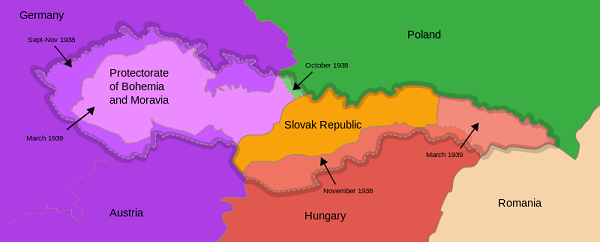 |
Above: In the map, German-speaking Sudetenland (light purple) surrounds Bohemia and Moravia (western Czechoslovakia). Slovakia and Ruthenia (eastern Czechoslovakia) are indicated in goldenrod and pink. Arrows with dates indicate territories that were gobbled up by Czechoslovakia’s hungry neighbors, ending the country’s 20 years of independence. Czech-mated, Great Britain and France, Czechoslovakia’s allies, stood stock-still rather than intervene to stop Hitler’s bloodless conquests—Chamberlain going so far to declare that Slovakian independence cancelled the Anglo-French guarantee to protect Czechoslovakia’s independence. Within six months Hitler switched from political coercion to military force that he had been prepared all along to unloose on countries that stood in his way.
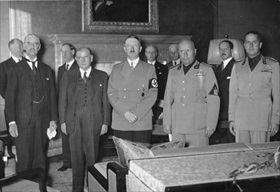 | 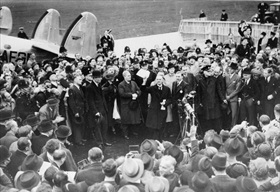 |
Left: British Prime Minister Chamberlain (left), French Prime Minister Daladier, Hitler, Italian Prime Minister Mussolini, and Italy’s Foreign Minister Galeazzo Ciano pose stiffly for the camera before signing the Munich Agreement shortly after 1 a.m., September 30, 1938. With the cynical stroke of a pen, four European powers had forced a sovereign democracy to cede a sizeable chuck of its territory to a totalitarian power. Of the two Western signatories, only Daladier recognized at the time that Hitler had played them for fools.
![]()
Right: On his triumphal return from Munich on September 30, 1938, Chamberlain (right of center) waves the paper containing the Anglo-German commitment to resolve differences between their two countries peacefully, which he and Hitler had signed a few hours earlier. He boasted: “The settlement of the Czechoslovakian problem,” resolved by the European Great Powers detaching Czechoslovakia’s mostly German-speaking Sudetenland (3.1 million people) and handing it over to Germany, “has now been achieved [and] is, in my view, only the prelude to a larger settlement in which all Europe may find peace.” Less than a year later Chamberlain took to the BBC, announcing to the world on September 3, 1939, that his country and France were now at war with Germany.
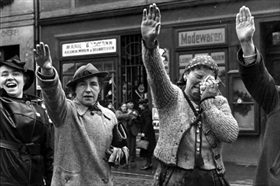 | 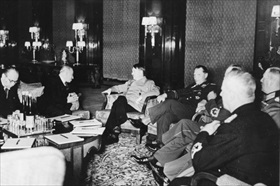 |
Left: Arms raised in a Hitler salute people in the Sudeten town of Eger (Czech, Cheb), among them a woman wiping away tears of joy, line the street as German troops enter the town in early October 1938 following the Munich Agreement.
![]()
Right: Hitler (middle in photo) facing Czech President Emil Hácha in discussions in his new Reich Chancellery in Berlin on March 14–15, 1939, hours before the German invasion of the Czech heartland, Bohemia and Moravia. In poor health anyway, Hácha suffered a heart attack after Hitler placed a document and pen in front of him, demanding the de facto capitulation of Czech troops to the Wehrmacht (German armed forces). Hitler quickly summoned his always-present personal physician, Dr. Theodor Morell, to revive Hácha. By signing the document the Czech president ended his country’s 20 years of independence.
Silent Newsreel Clip Showing German Wehrmacht and Hitler’s Entry into Czechoslovakia, March 1939
![]()

 History buffs, there is good news! The Daily Chronicles of World War II is now available as an ebook for $4.99 on Amazon.com. Containing a year’s worth of dated entries from this website, the ebook brings the story of this tumultuous era to life in a compelling, authoritative, and succinct manner. Featuring inventive navigation aids, the ebook enables readers to instantly move forward or backward by month and date to different dated entries. Simple and elegant! Click
History buffs, there is good news! The Daily Chronicles of World War II is now available as an ebook for $4.99 on Amazon.com. Containing a year’s worth of dated entries from this website, the ebook brings the story of this tumultuous era to life in a compelling, authoritative, and succinct manner. Featuring inventive navigation aids, the ebook enables readers to instantly move forward or backward by month and date to different dated entries. Simple and elegant! Click 











